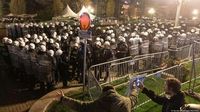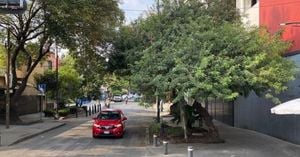A significant wave of protests engulfed Belgrade on March 15, 2025, as hundreds of thousands marched to honor the victims of the earlier Novi Sad railway station disaster. The event turned chaotic when what eyewitnesses described as an "unnatural" noise erupted during a 15-minute silent vigil, leading to panic and confusion among protesters.
Witnesses reported the chilling sound as akin to something from a movie, with comparisons to rushes of wind or even jet planes. Marija Simin, attending the protest as a teacher from Novi Sad, recounted her experience: "We only had so much time to look at each other and say: 'What is this?'" The immediate environment turned frenzied as participants ran for cover; Simin ended up falling and injuring herself during the stampede.
The incident raised serious allegations against the authorities, with many claiming the noise was the result of security forces utilizing a “sonic cannon.” Interior Minister Ivica Dacic flatly denied the accusation: "The police did not use any illegal methods during the protest." He insisted on the authenticity of the event being peaceful and requested written statements from all units involved.
This claim of sonic weaponry was categorically refuted by Serbian President Aleksandar Vucic as he vowed to protect against any such escalation reminiscent of the EuroMaidan Revolution in Ukraine. He noted, "There were no wounded; nothing happened to anyone, but they have to come up with something." Vucic has repeatedly dismissed the notion of any military devices being used, attributing the incident to the anxiety within the crowd.
The protest itself, part of larger anti-government sentiments sparked by the November 2024 collapse of the Novi Sad train station roof which killed 15, saw attendance estimates ranging controversially from about 107,000 (according to the Interior Ministry) to between 275,000 and 325,000 as reported by NGOs. This divergence showcases the heightened tension surrounding the event.
Outrage over the disaster linked to what many viewed as corrupt practices fueled student-led initiatives to demand accountability from government officials. Vucic's administration has not only faced criticism due to the station disaster but also for prior incidents of government mismanagement, alleged corruption, and cronyism.
Adding to the atmosphere of unrest, stones and bottles were reportedly thrown from counter-demonstrators located at Pionirski Park, leading to heightened tensions with police forces guarding the opposite National Assembly. This tumult was characterized by the chaotic scenes captured across social media, with videos showing masses dispersing toward safety.
Despite the allegations of police misconduct, including claims about deploying sonic weapons, Vucic emphasized the need for the government to investigate what he has described as "brutal fabrications and lies" surrounding the protests and their management.
Military analyst Aleksandar Radic noted the sound could have stemmed from devices known as Long Range Acoustic Devices (LRAD), which are often utilized for crowd control. Such usages raise serious legal questions under Serbian Policing laws, with NGOs condemning any unlawful deployment of such devices against peaceful protests.
The Serbian protests, the largest recorded to date, pose the most significant challenge to Vucic's 13-year presidency. Since the protests began, key resignations have ensued, including Serbian Prime Minister Milos Vucevic and Novi Sad Mayor Milan Djuric, showing cracks within the government and highlighting the unrest among citizens.
The uncertain climate leading up to the protests appears to stem from mounting frustrations around misgovernance, alleged corruption, and failure to uphold accountability mechanisms within the government. Following this protest, Vucic's administration finds itself at yet another crossroads, preying on fears of mass public dissent echoing past revolutions across Europe.






